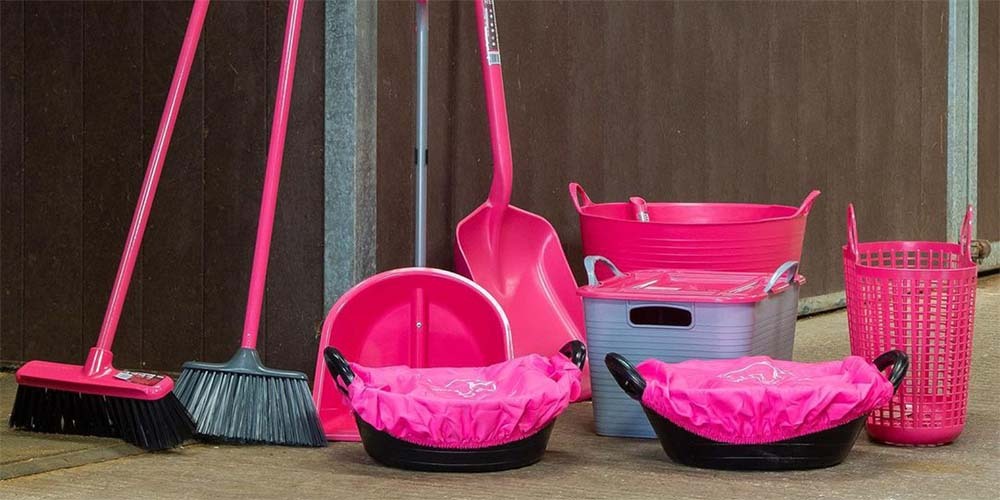10 Tips for Good Stable Maintenance
Apr 18th 2023

We all know stable maintenance can be a little bit of a chore, but a good routine is a vital part of your horse's care and improves their overall health and well-being. By incorporating some of these 10 tips for good stable maintenance into your practice, you can create a well-thought-out routine, and before you know it, your daily tasks will become a breeze.
10 Tips for Good Stable Maintenance
Daily Maintenance Tasks
1. Good Practices
Pick out your horses' feet before entering and leaving the stable. This will prevent your horse from trailing unwanted dirt, mud, and stones into the stable or around the yard. Easy things like sweeping the stable and picking up any excess hay off the floor will help maintain a clean and tidy environment. Always have a quick look around your stable to make sure you don't leave any tools that could be harmful to your horse.
2. The Right Tools for The Job
Effortless maintenance starts with having the right tools to hand. It will not only save you time but will make cleaning more straightforward, so you don't lose the will to clean before you even begin. The types of tools you require will depend on the type of bedding you have:
- Shavings & Wood Pellets - Shavings Fork/Bedding Fork
- Straw - Pitchfork
Other tools you may require are a poo scoop, broom and even a Tidee Rake. These are optimal pieces of equipment that allows you to quickly skip out and remove any manure.
Colour-coordinating your cleaning tools and feed and water buckets will help to stop cross-contamination. Cross-contamination can occur if one horse is on medication and another is not, and can even lead to a possible doping issue if your horse is out competing. Red Gorilla's recyclable storage, including their tubs and water buckets are perfect for preventing this. Their flexible tubs and water buckets come in various sizes and colours, so you can create matching sets or allocate colours to identify what items belong to which horse. Having different coloured water buckets is also good practice, helping you determine which bucket is for drinking, bathing, or medical purposes.

3. Fresh Water
Make sure your horse always has access to the freshwater they need on a daily basis. Whether you use a bucket, trough, or water drinker, you can give your container a quick brush round to clean it and remove any debris that may have got in. When the colder months come around, check that the water isn't frozen, so your horse stays hydrated.
Weekly Maintenance Tasks
4. Thorough Muck Out
You should be clearing out all of the manure and wet bedding in your horse's stable on a regular basis. Sift through to try and salvage any clean bedding that can be reused to save on wastage. If you do not have time to turn the banks during your daily muck out, allocate some time at the end of the week to turn them over. Banks should be fully dug out and pulled into the middle before adding new bedding to replace the banks where needed. Once or twice a week, top up your stable with fresh bedding as necessary. Our favourite tip for mucking is to clear the area before you start. By removing tools, toys and anything placed on the floor, such as feed and buckets, you get free rein of the floor space and achieve a thorough clean.
5. Organisation
Good tack room organisation is the best way to keep all your equipment in good condition. An optimal way to do this is to use a storage box like Red Gorilla's Stack n Store. These boxes are perfect for storing your essentials as they have lids to keep your items clean and dry and can neatly stack to save space. It is also necessary to look at feed storage solutions. Large bags of feed should be kept in storage bins to prevent spoiling and cross-contamination. If you choose to make up your feeds prior to feeding, you can protect them with Red Gorilla's TubTop Translucent Lids.
6. Unwanted Objects
Make sure there are no nails, wire or other debris that could be dangerous to your horse. Straw can sometimes contain the odd sharp stone picked up from the harvesting process. With this intention make sure to keep your eye out for those while you are mucking out.
Monthly/Annual Maintenance Tasks
7. Fixtures and Fittings
Check that all wall fixings, tie-up rings, and any hanging stable toys are secure. With this in mind check that these are in the best possible places for you and your horse. If you have any fixed hay mangers or feed bowls, ensure these are sturdy. In the tack room, check your bridle and saddle racks are secure to prevent mishaps.
8. Deep Clean
A deep spring clean is perfect for keeping your stable in good condition. This is an ideal time to de-cobweb and check the entire stable for protruding nails or broken areas. Next, if you have any rubber matting that is not sealed, lift and remove the mat from the stable. Pressure wash the stable with a bit of disinfectant to not only remove any ammonia smell, but to also help prevent diseases. Finish by pressure washing your rubber mats and leave them to fully dry before returning them.
9. Maintenance
To keep your stable and yard in good working order, general stable maintenance will be required. This could include painting, weeding, and cleaning out drains and gutters. Keeping on top of repairs will also ensure you and your horse are kept safe.
10. Keep it Clean
Maintaining your equipment and keeping everything systematically in order and clean will help ensure your horse's environment is hygienic and safe from any nasties. Try to wash your mucking out tools at the start of each season to ensure they are always clean and in working order.
We hope you have found these top 10 tips for good stable maintenance tips useful, and you will be able to implement these into your own routine to keep your horse happy and healthy. If you're missing any of the gear to carry out these vital steps, our range of buckets and stable equipment has got you covered!


